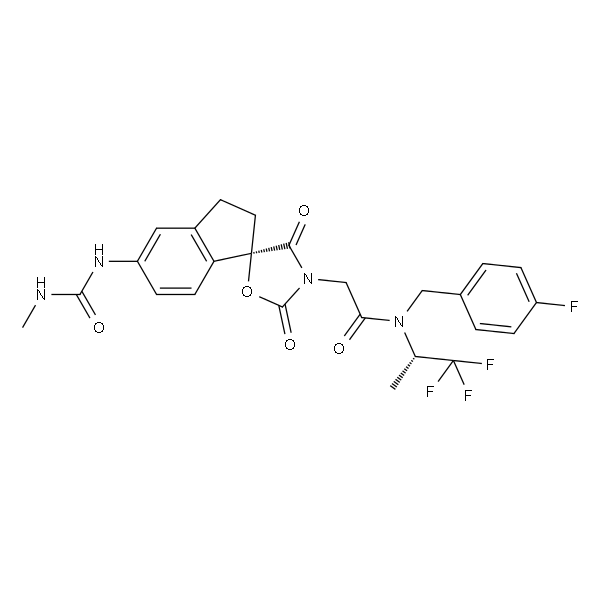| CAS |
1889279-16-6 |
| English Name |
A-485 |
| Synonyms |
(1R)-N-[(4-Fluorophenyl)methyl]-2,3-dihydro-5-[[(methylamino)carbonyl]amino]-2',4'-dioxo-N-[(1S)-2,2,2-trifluoro-1-methylethyl]spiro[1H-indene-1,5'-oxazolidine]-3'-acetamide; |
| Molecular Formula |
C25H24F4N4O5 |
| Molecular Weight |
536.48 |
| Solubility |
Soluble in DMSO |
| Purity |
≥98% |
| Appearance |
White to off-white Solid |
| Storage |
Powder:2-8℃,2 years;Insolvent(Mother Liquid):-20℃,6 months;-80℃,1 year |
| MDL |
MFCD31619258 |
| SMILES |
O=C(N1CC(N([C@@H](C)C(F)(F)F)CC2=CC=C(F)C=C2)=O)[C@]3(OC1=O)C4=CC=C(NC(NC)=O)C=C4CC3 |
| Target Point |
p300/CBP |
| Passage |
Epigenetics |
| Background |
A-485 is a potent and selective p300/CBP catalytic inhibitor. |
| Biological Activity |
A-485 is a potent and selective catalytic inhibitor of p300/CBP with IC50s of 9.8 nM and 2.6 nM for p300 and CBP histone acetyltransferase (HAT),respectively[1]. |
| IC50 |
9.8nM(p300),2.6nM(CBP)[1] |
| In Vitro |
A three-hour treatment of prostate adenocarcinoma PC-3 cells with A-485 results in a dose-dependent decrease in H3K27Ac,with a half maximal effective concentration(EC50)of 73 nM. Treatment with A-485 does not alter p300 or CBP protein levels.The broadest sensitivity is observed in haematological tumours,where A-485 exhibits potent activity in most multiple myeloma cell lines,and in a subset of acute myeloid leukaemia lines and non-Hodgkin’s lymphoma lines. A-485 induces a comparable decrease in H3K27Ac in all five prostate cancer cell lines[1]. |
| In Vivo |
After tumours are established in SCID male mice,twice daily intraperitoneal injections of A-485 induce 54% tumour growth inhibition after 21 days of dosing(P<0.005 as compare to vehicle control). In addition,in tumour-bearing animals,dosing with A-485 for seven days induces a decrease in the mRNA levels of MYC and the AR-dependent gene SLC45A3 at three hours post-dosing,and(for MYC)a decrease in the protein level,indicating that A-485 inhibits p300-mediated transcriptional activity in vivo. However,at 16 hours post-dosing on the seventh day,A-485 drug levels in the plasma and tumour are decreased as compare to 3 hours. A-485 induces a moderate 9% body weight loss,and the animals recover rapidly upon completion of the A-485 dosing regimen[1]. |
| Cell Experiment |
The LuCap-77 CR prostate PDX model is used in this study. Donor tumors are dissociated and injected as a brie(1:2)into the right flank of 16 week old male C.B.-17 SCID mice on day 0 in a volume of 0.2 mL. Tumors are size matched on day 26 post-inoculation with a mean tumor volume of 211±3(SEM)mm3 with dosing beginning on day 28. Mice are randomized into treatment groups using Studylog software based on tumor volume. LuCap-77 CR xenograft tumors are established in SCID mice and animals are dosed with A-485 as for 7 days. Three hours post the final dose,tumors are harvested and snap frozen on dry ice[1]. |
| Animal Experiment |
Cell lines are plated in 96 well or 384 well plates and allowed to adhere for 24 h. The cells are then treated with A-485 for 3,4,or 5 days. Experiments are run in triplicate and the fraction of viable cells is determined using the Cell Viability Assay according to the manufacturer’s recommendations. For Thymidine incorporation assays,cells are treated with A-485 for 1,2,3,or 4 days. Twenty four hours prior to the time point,tritiated thymidine is added and cells are incubated for an additional 24 h. Genomic DNA is then isolated on filter plates[1]. |
| Data Literature Source |
[1]. Lasko LM,et al. Discovery of a selective catalytic p300/CBP inhibitor that targets lineage-specific tumours. Nature. 2017 Oct 5;550(7674):128-132. |
| Unit |
Bottle |
| Specification |
1mg |


 English
English
 中文
中文

 Manual Download
Manual Download

